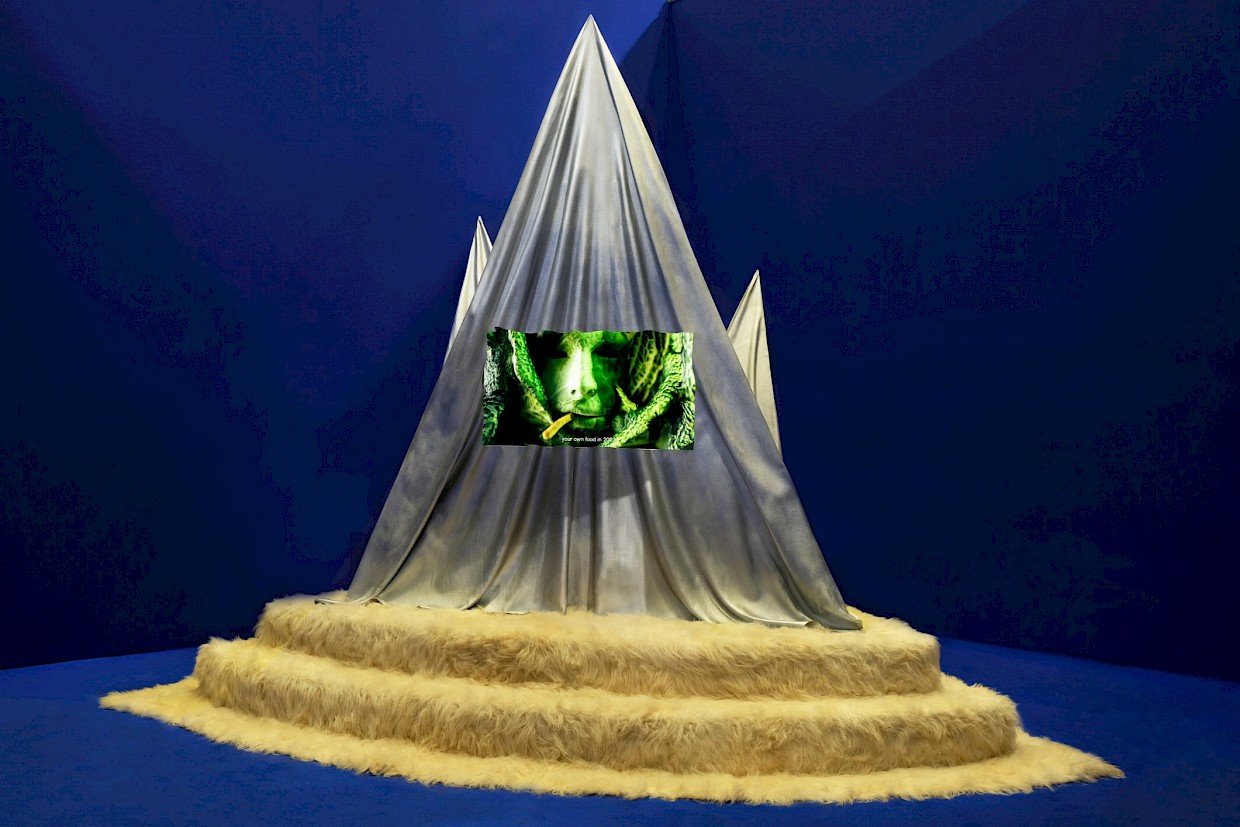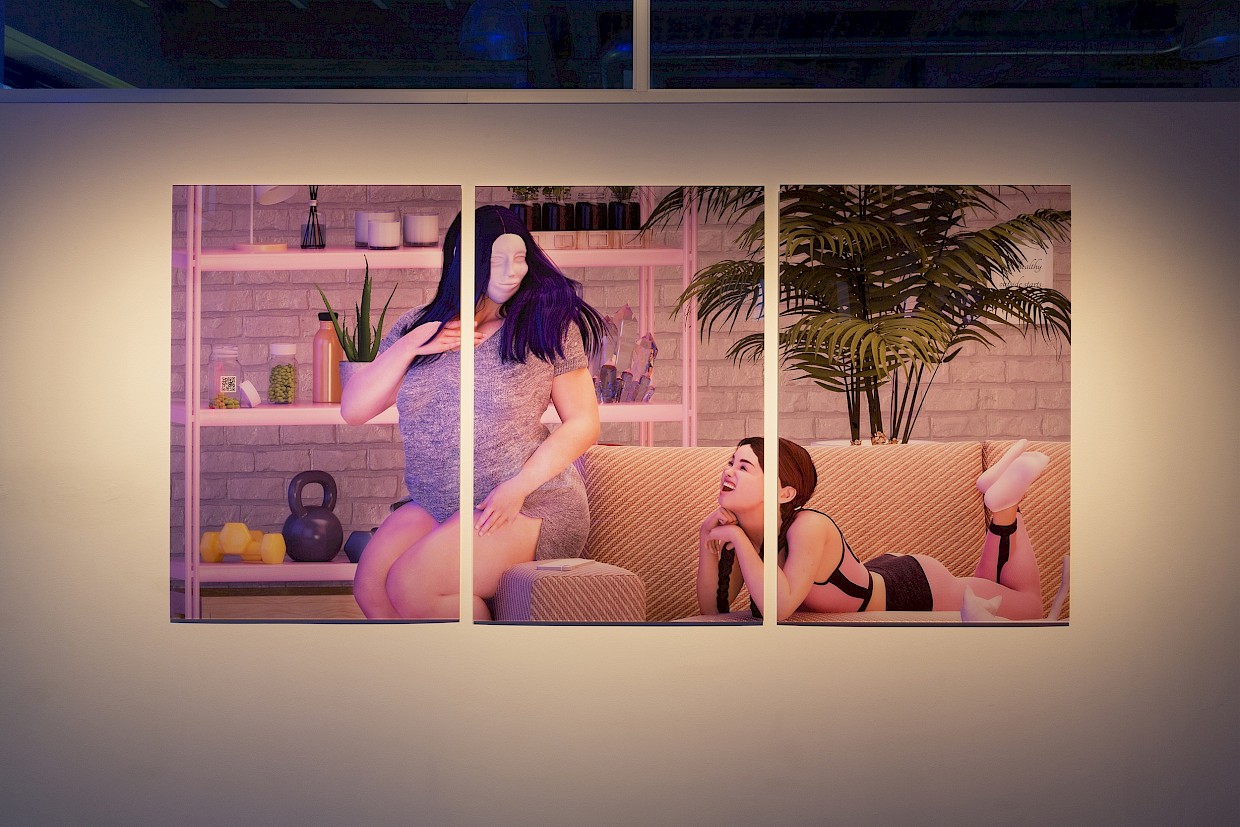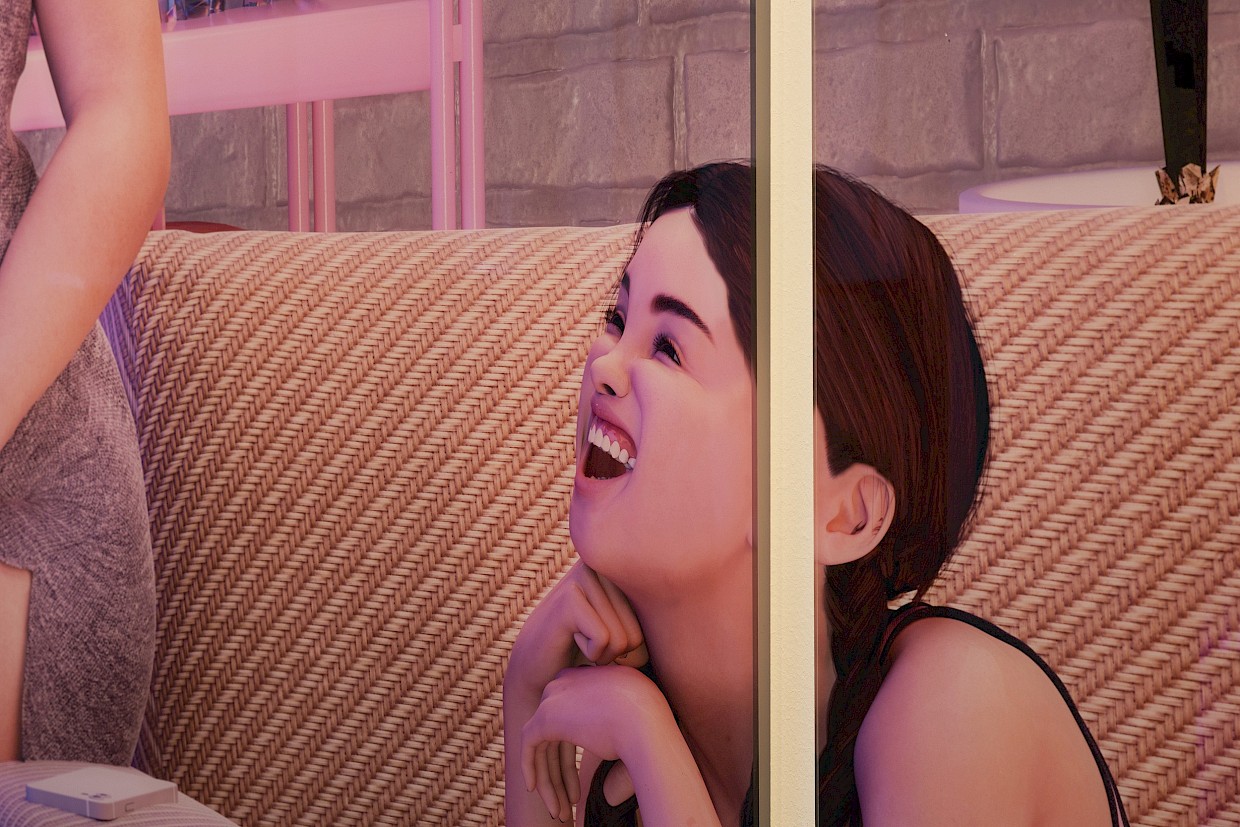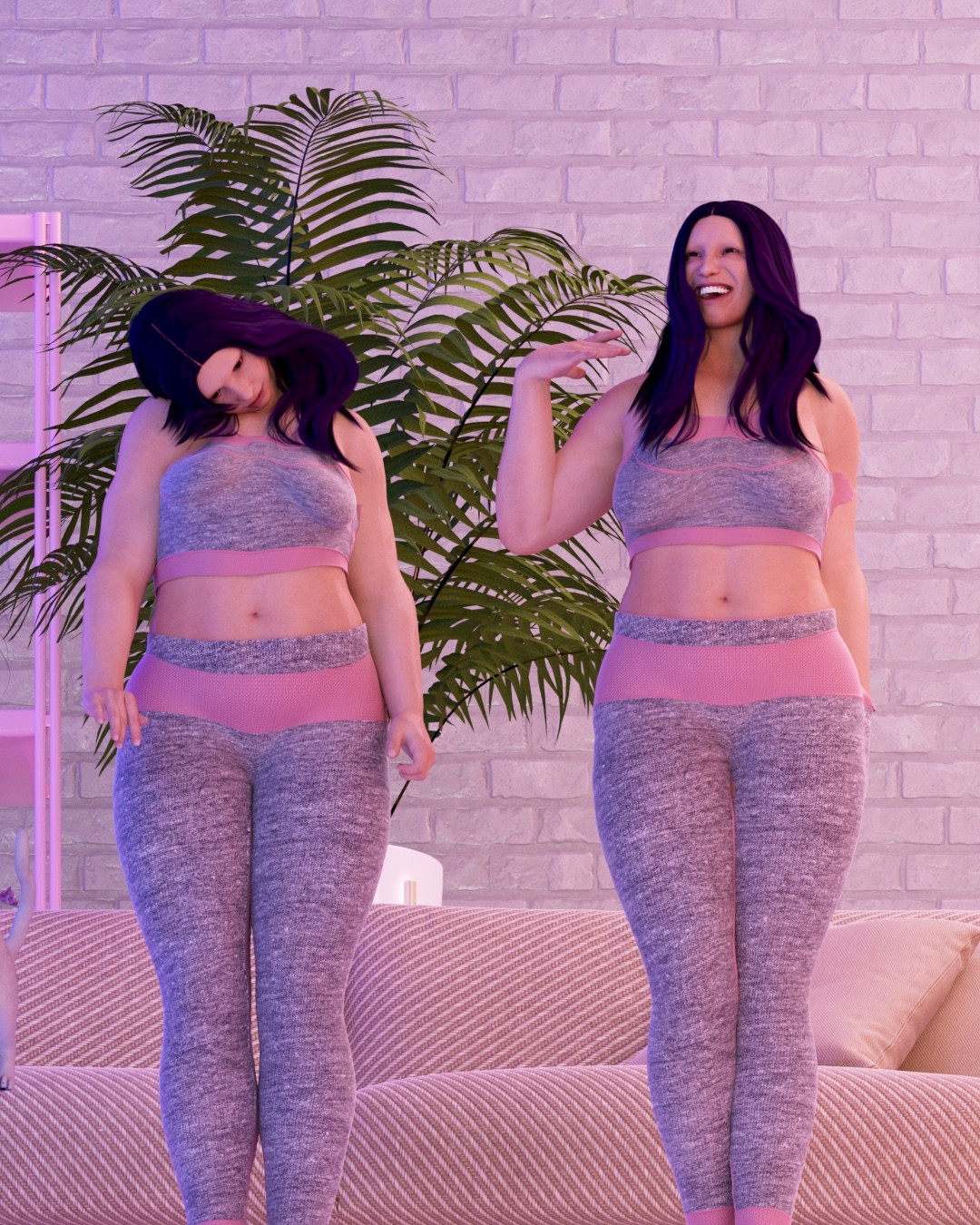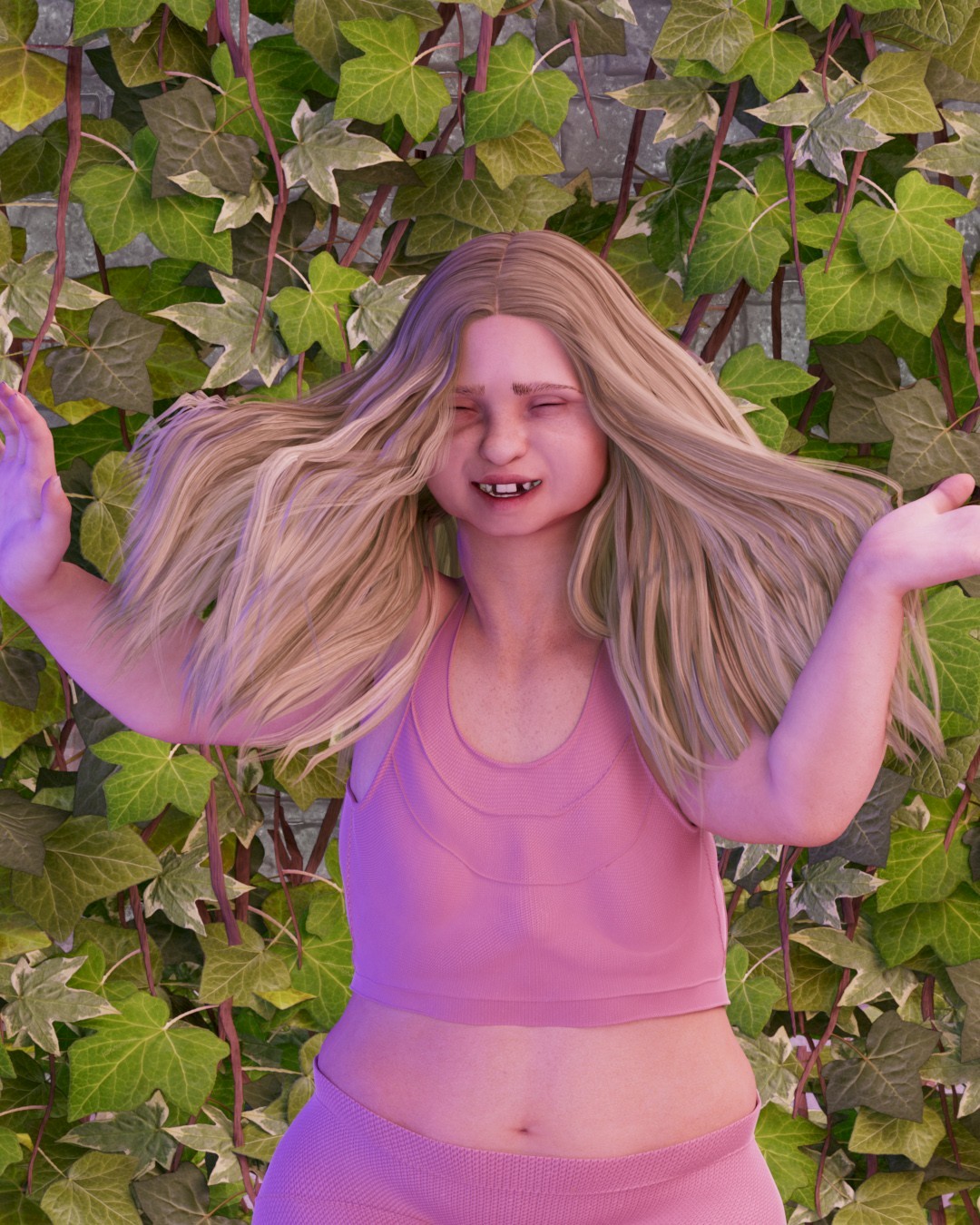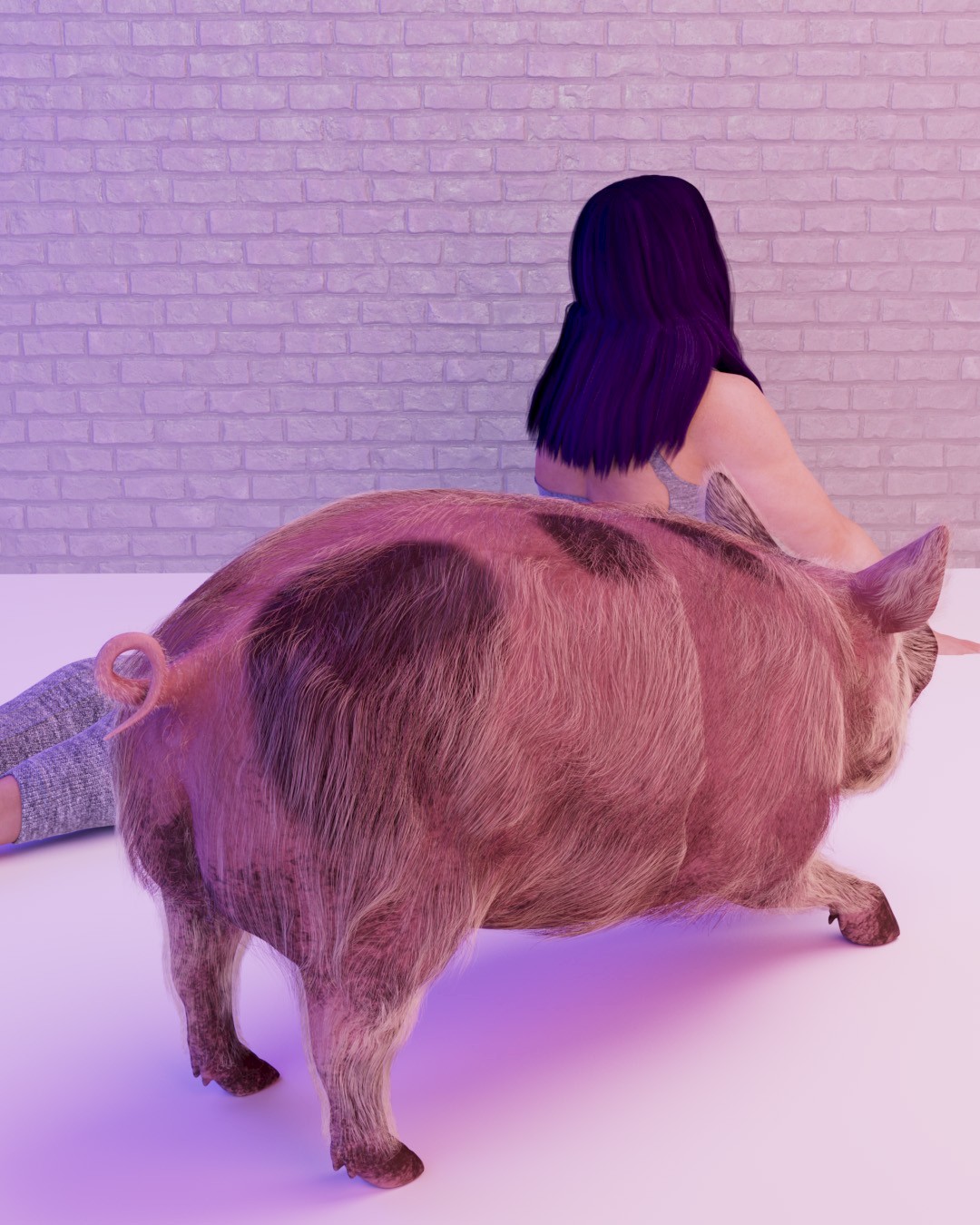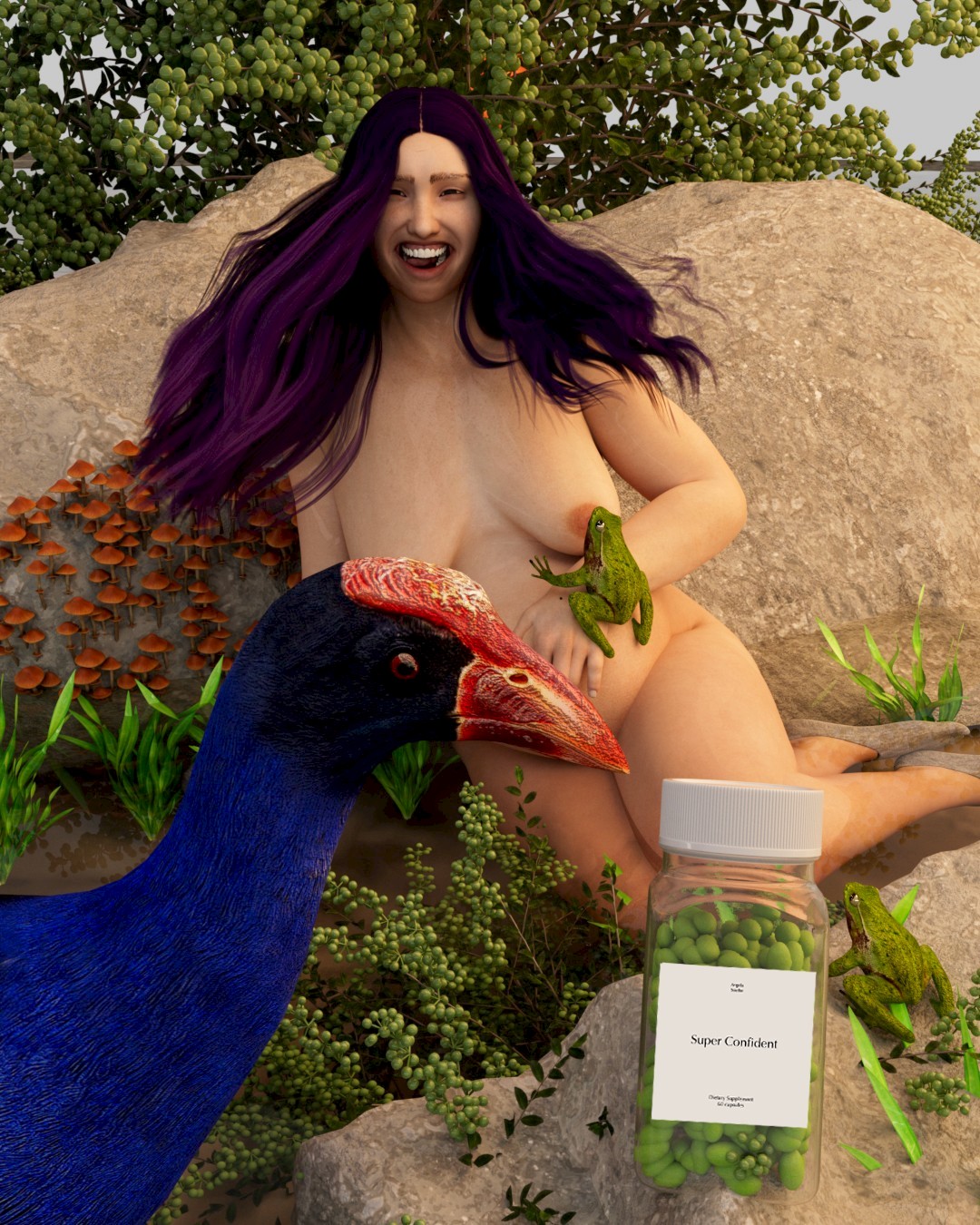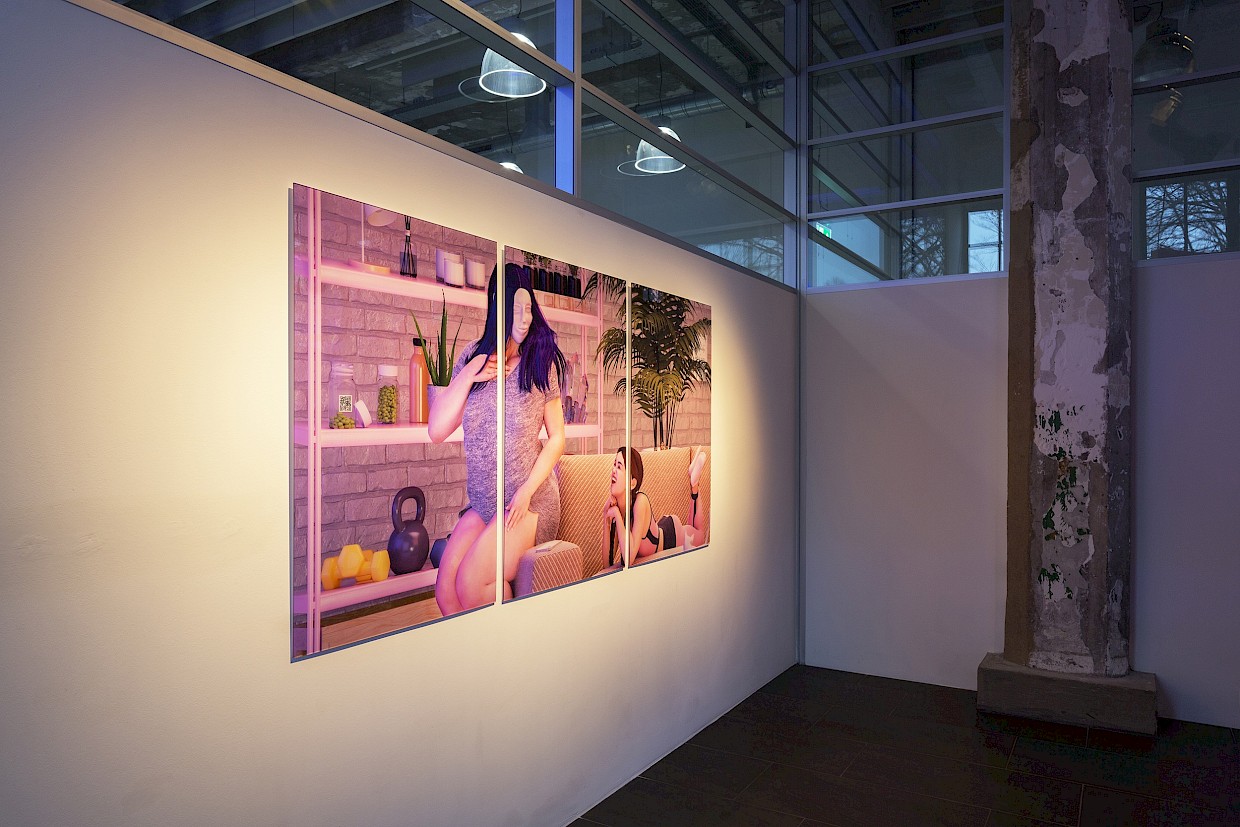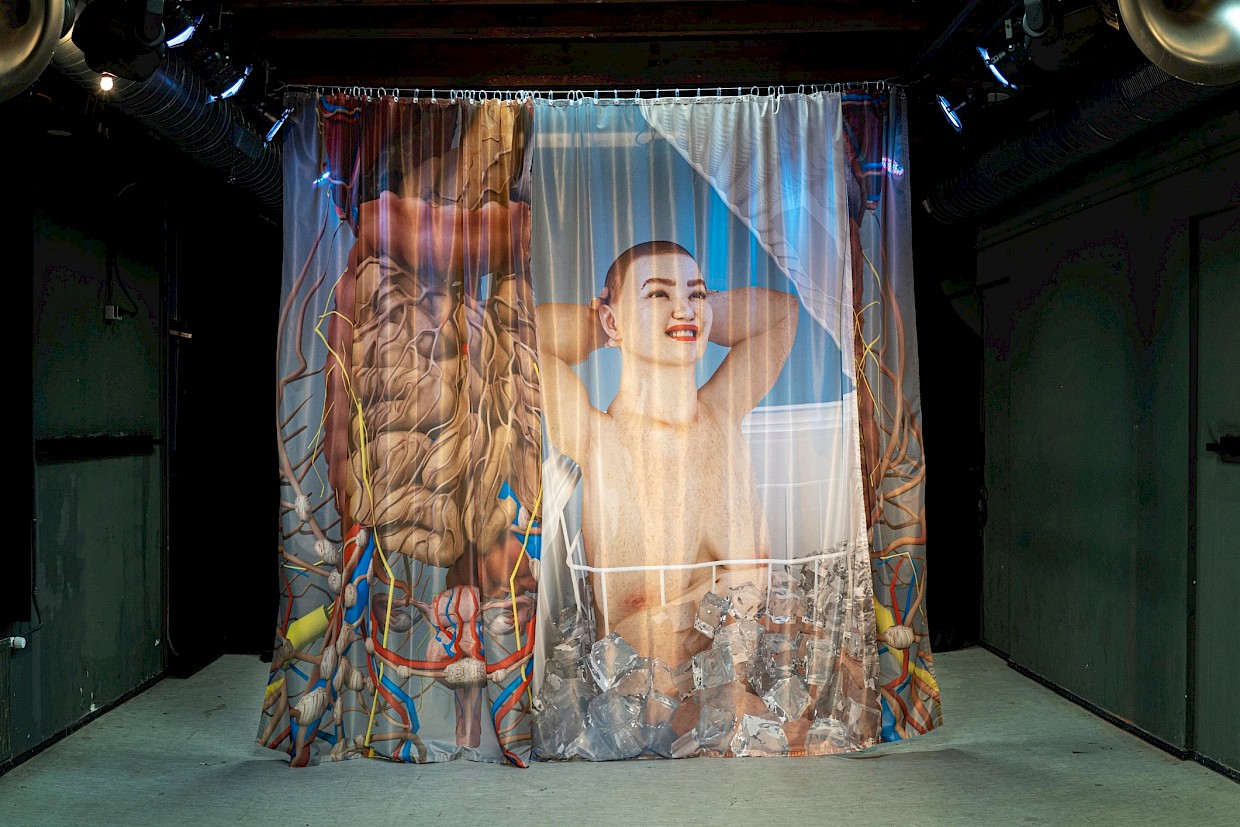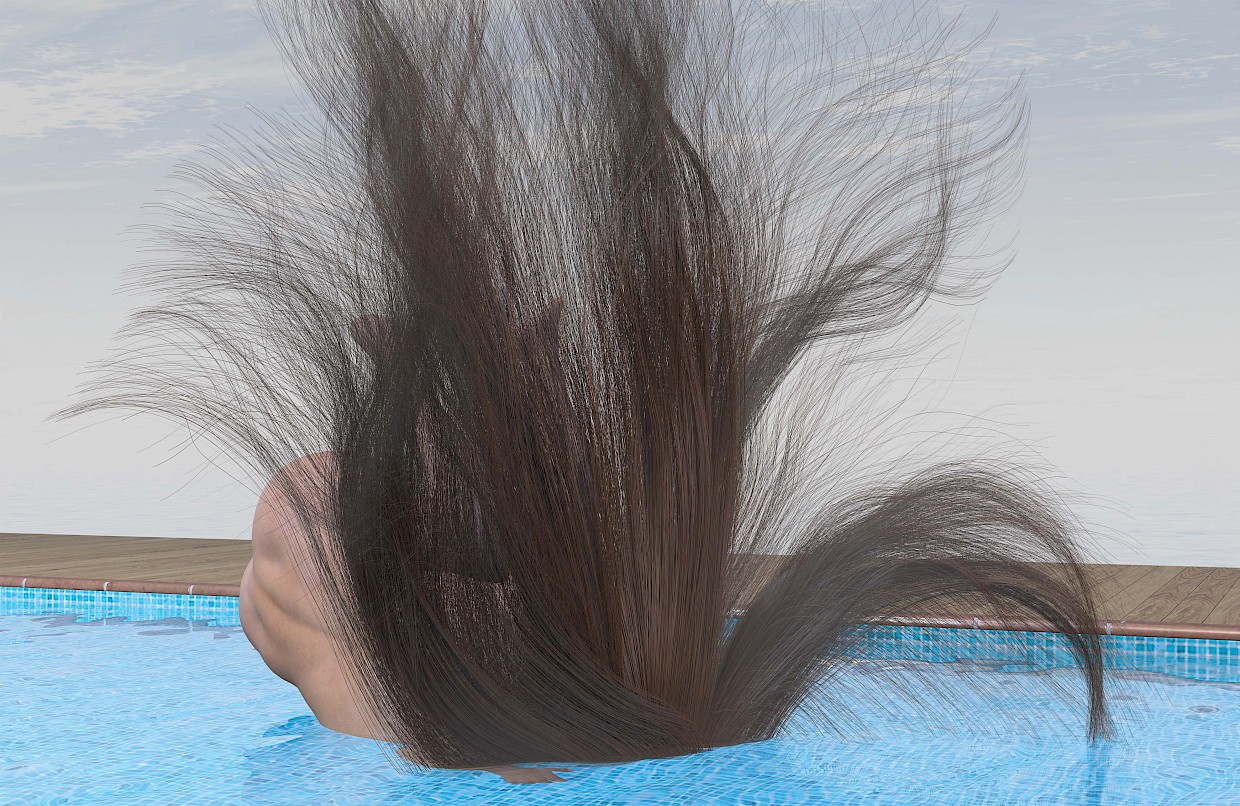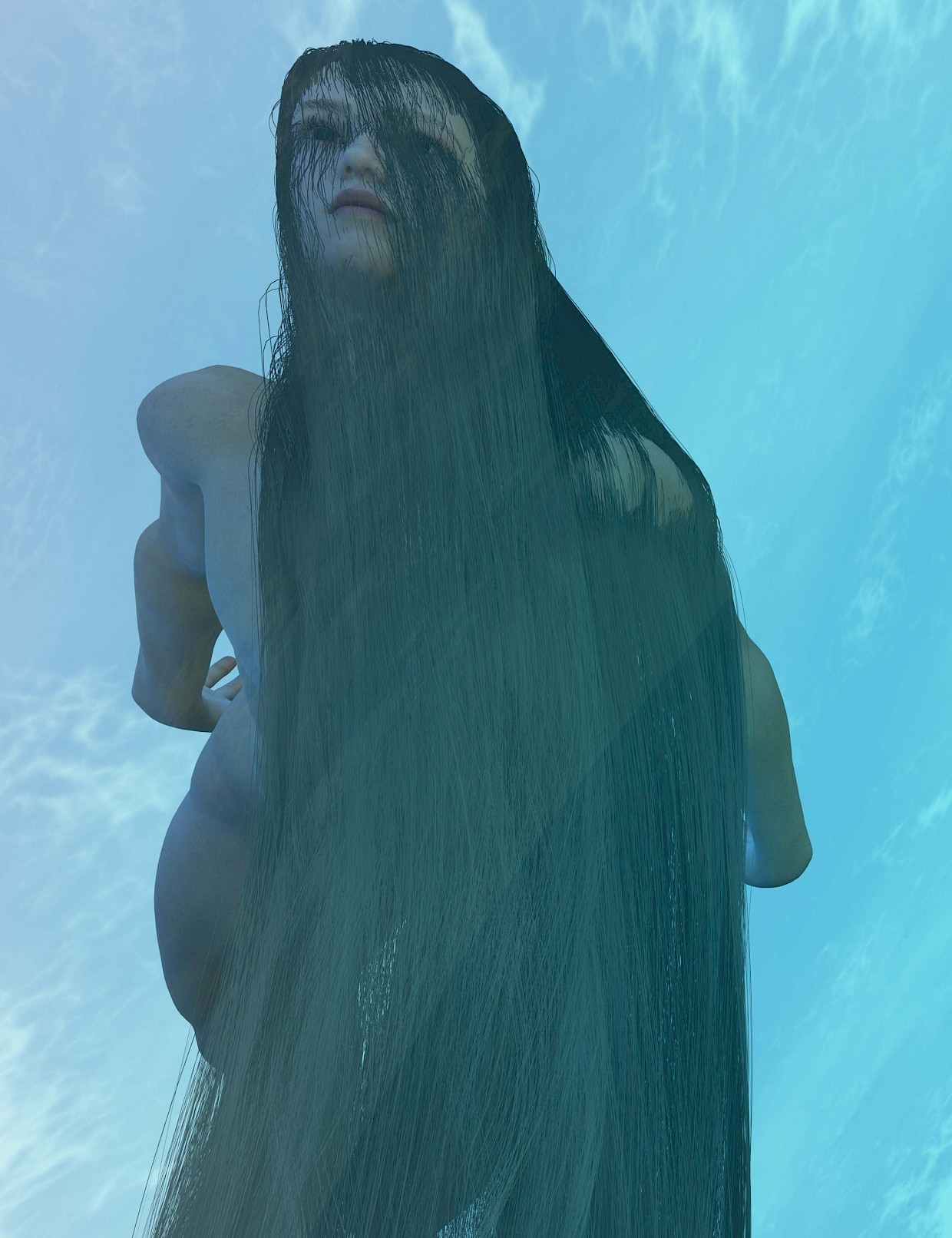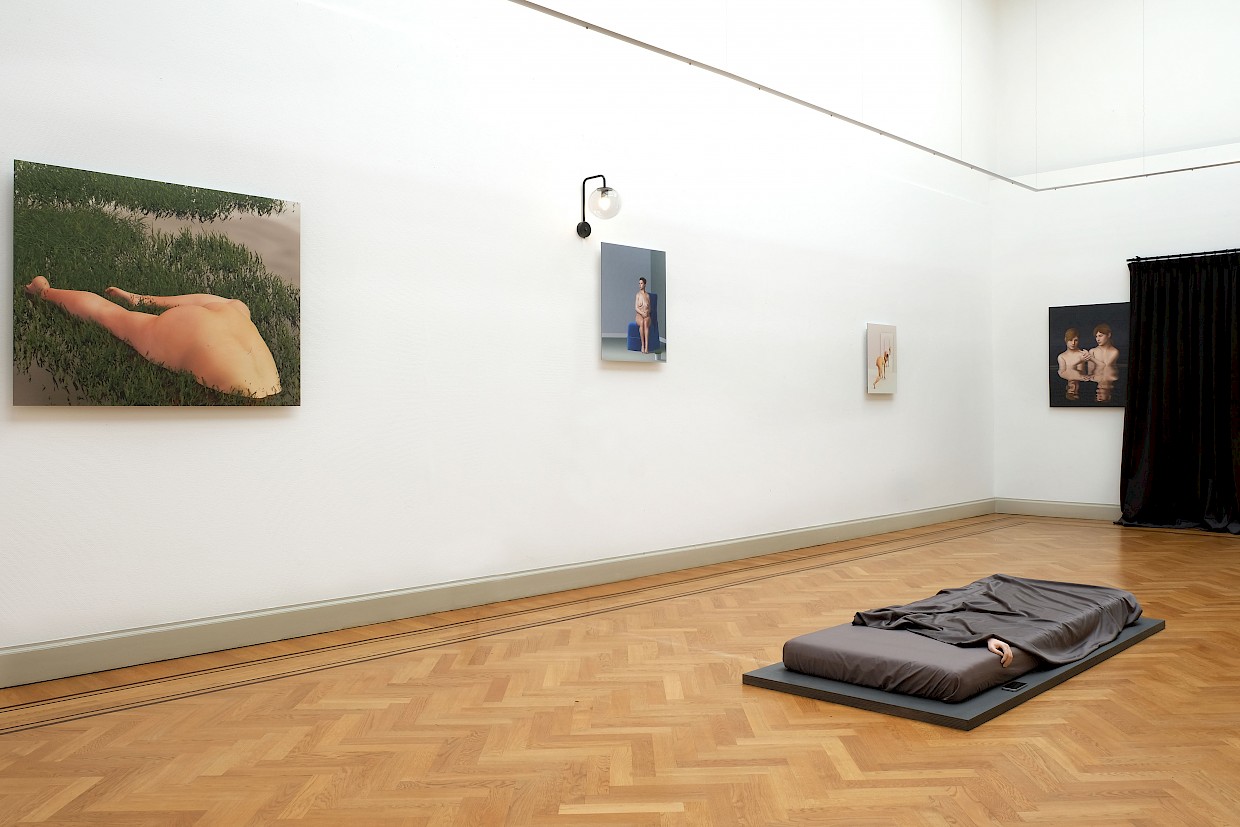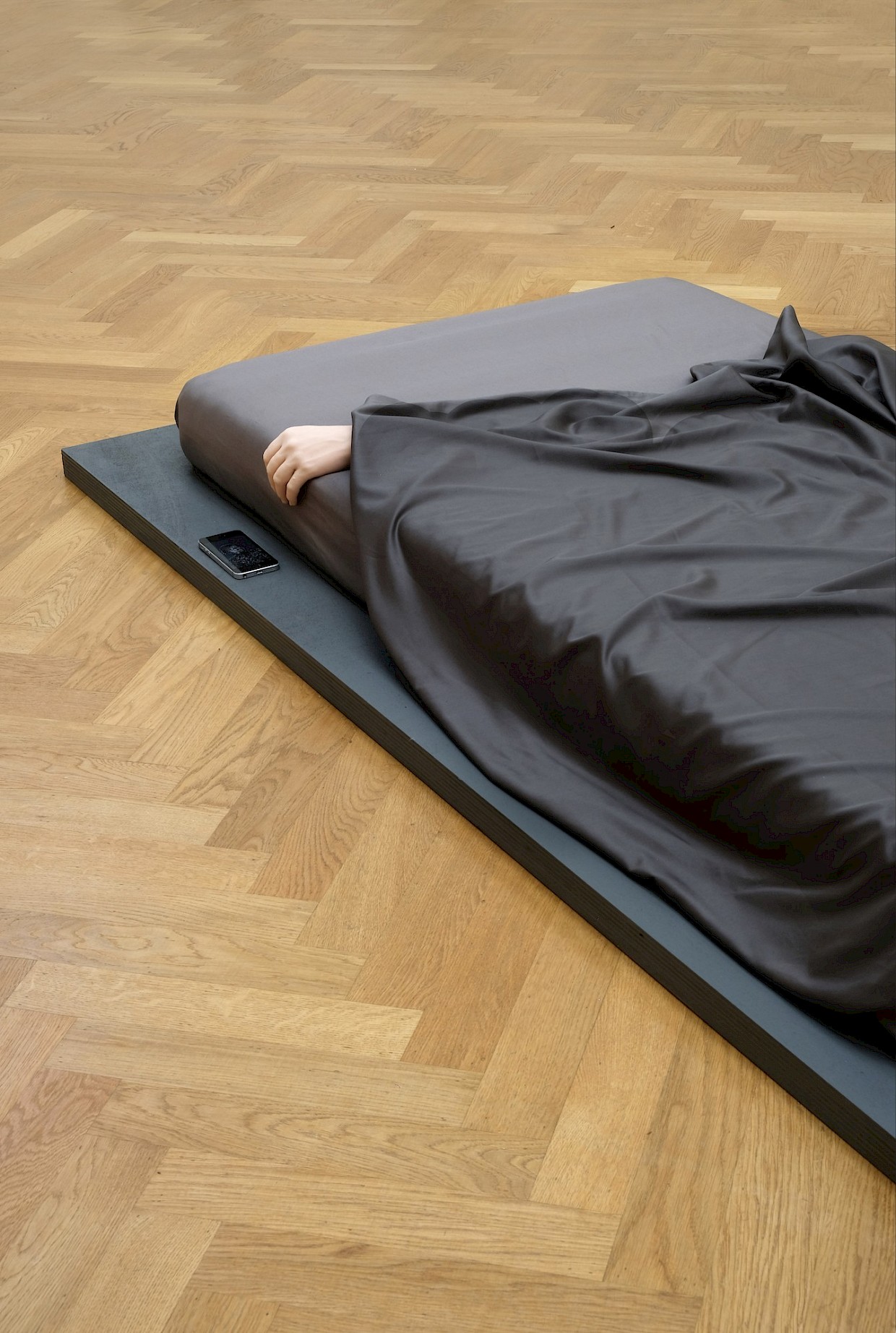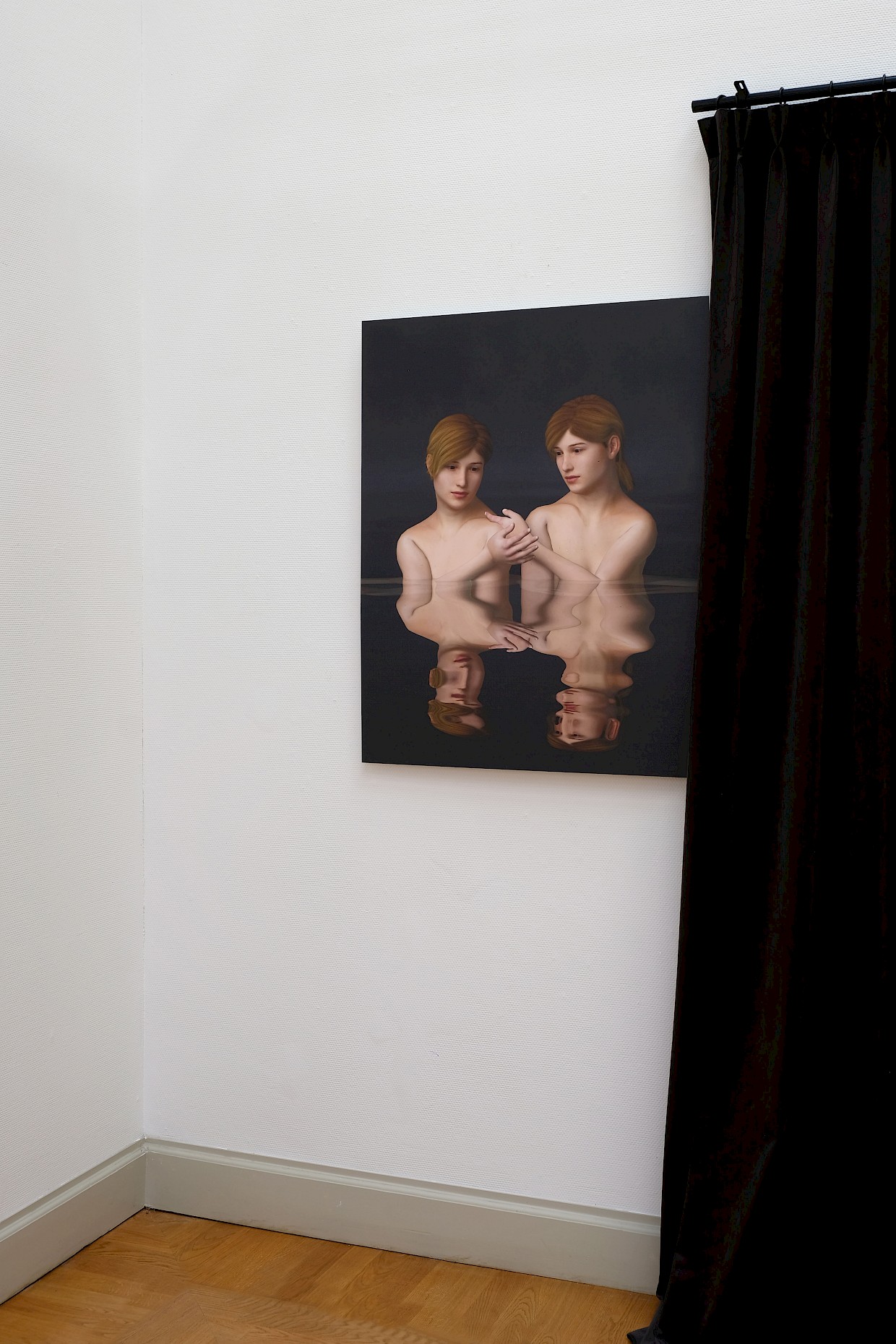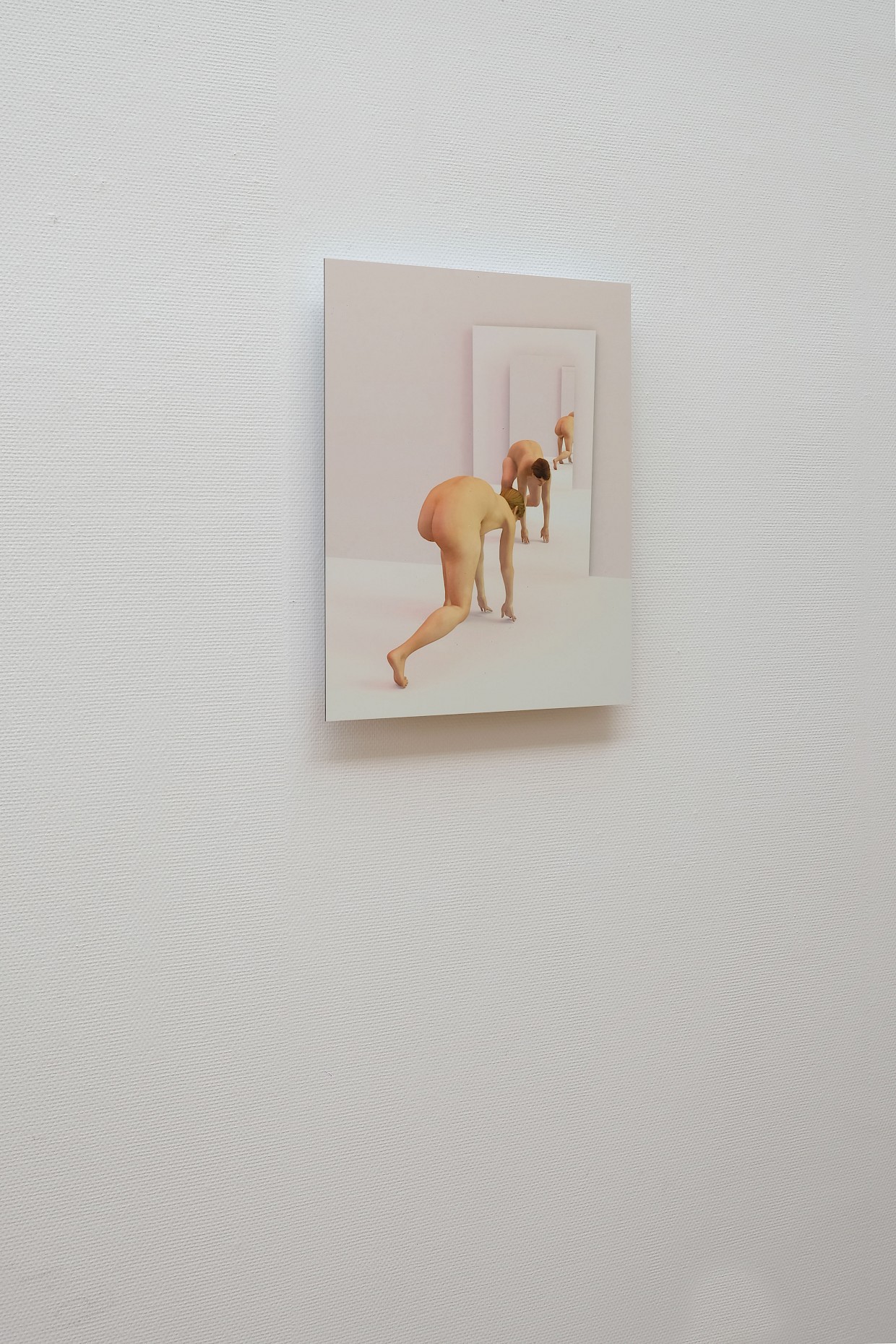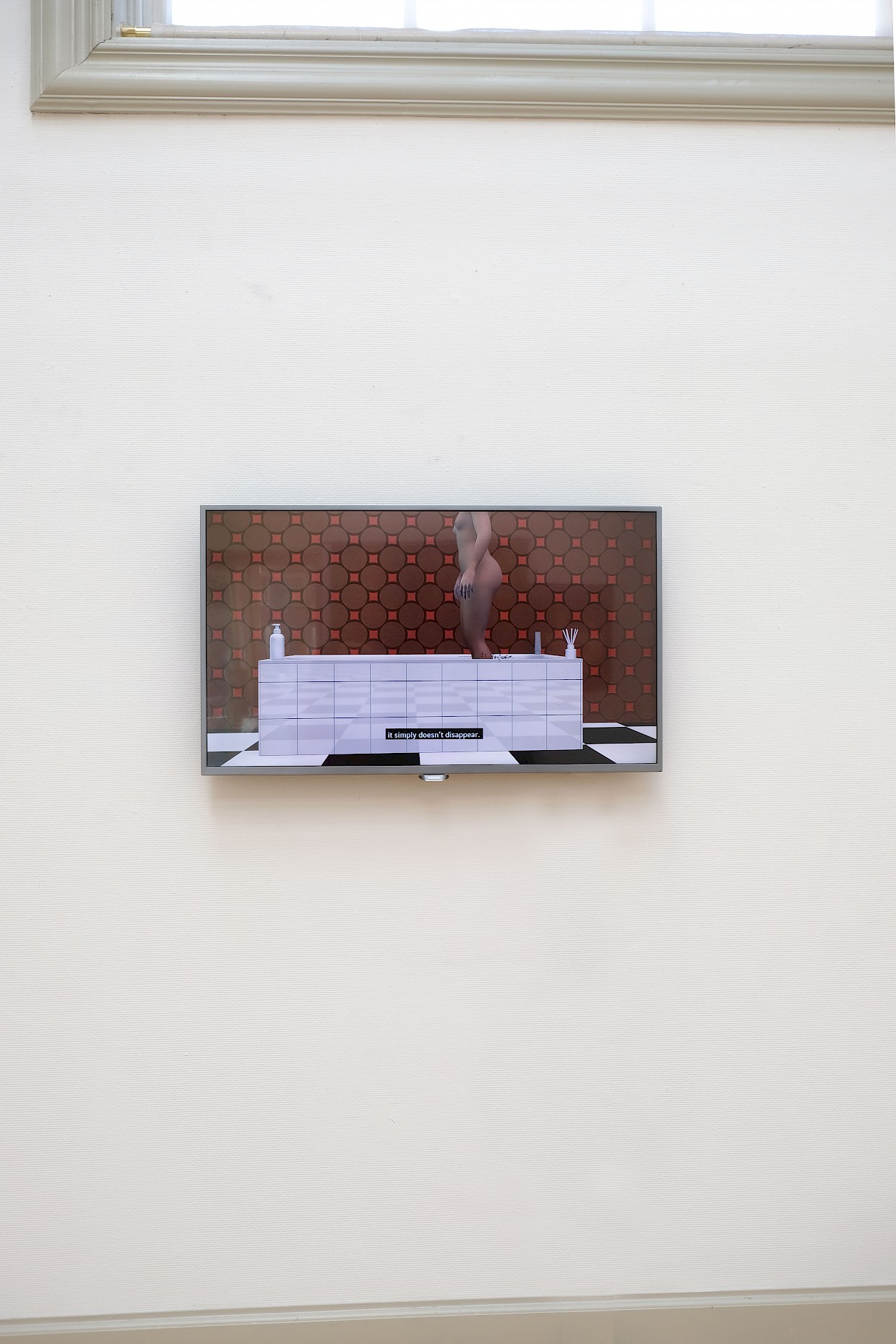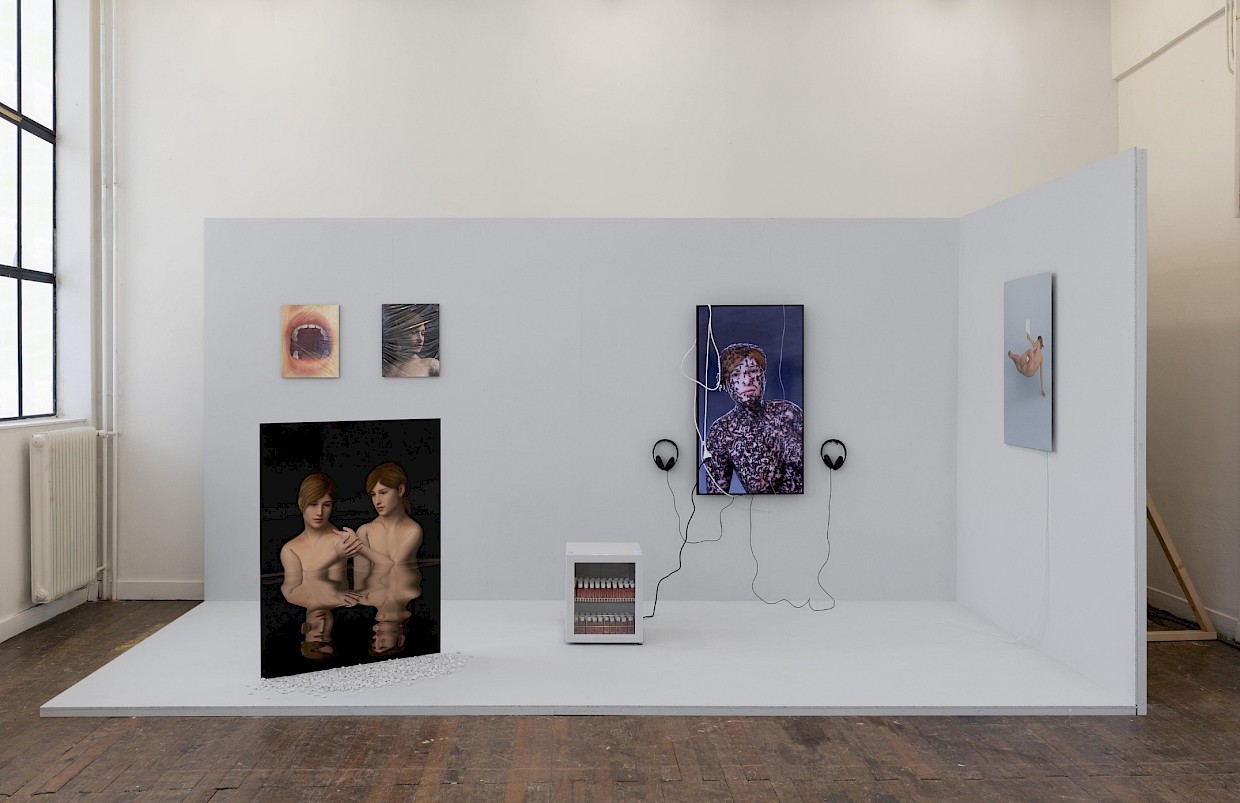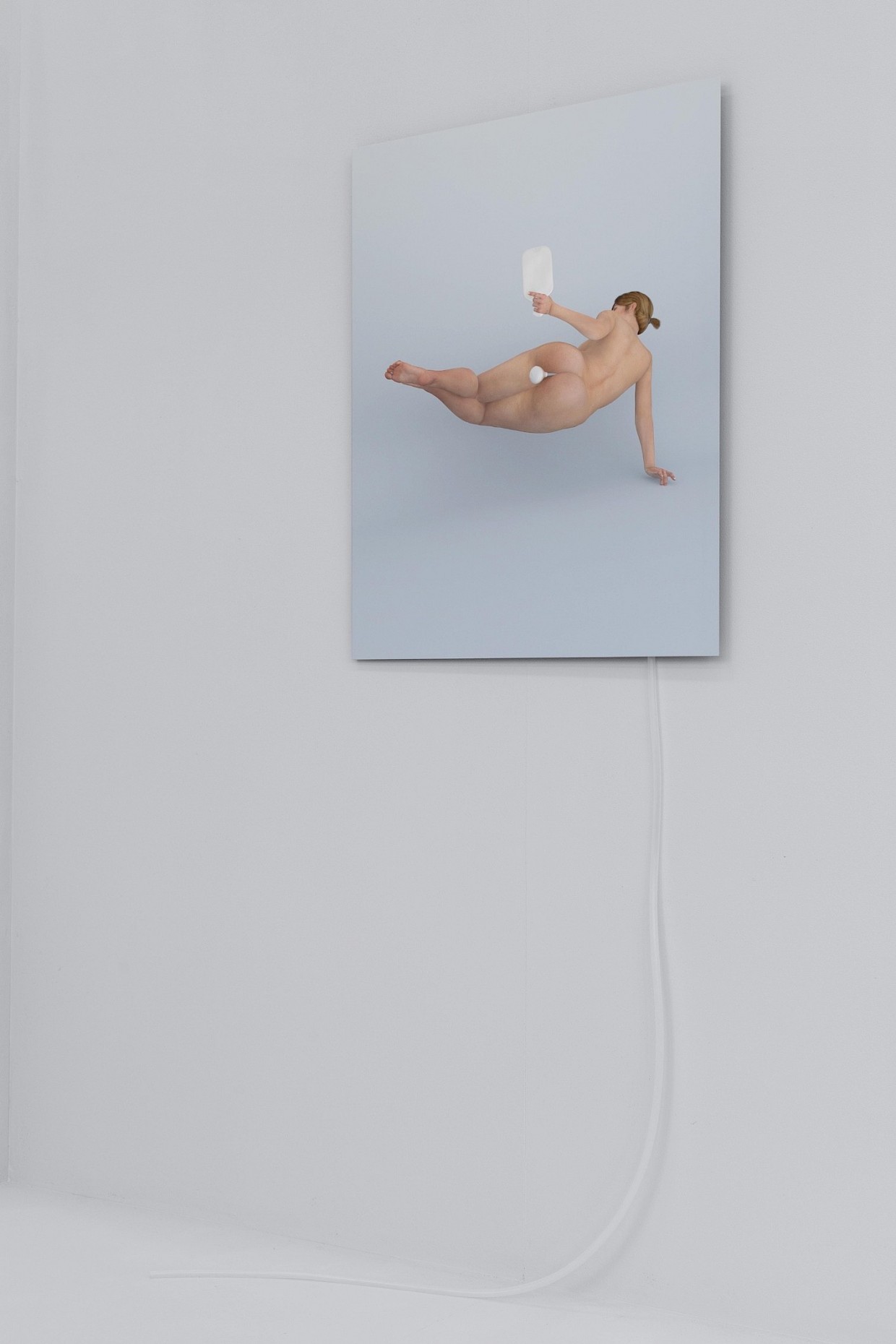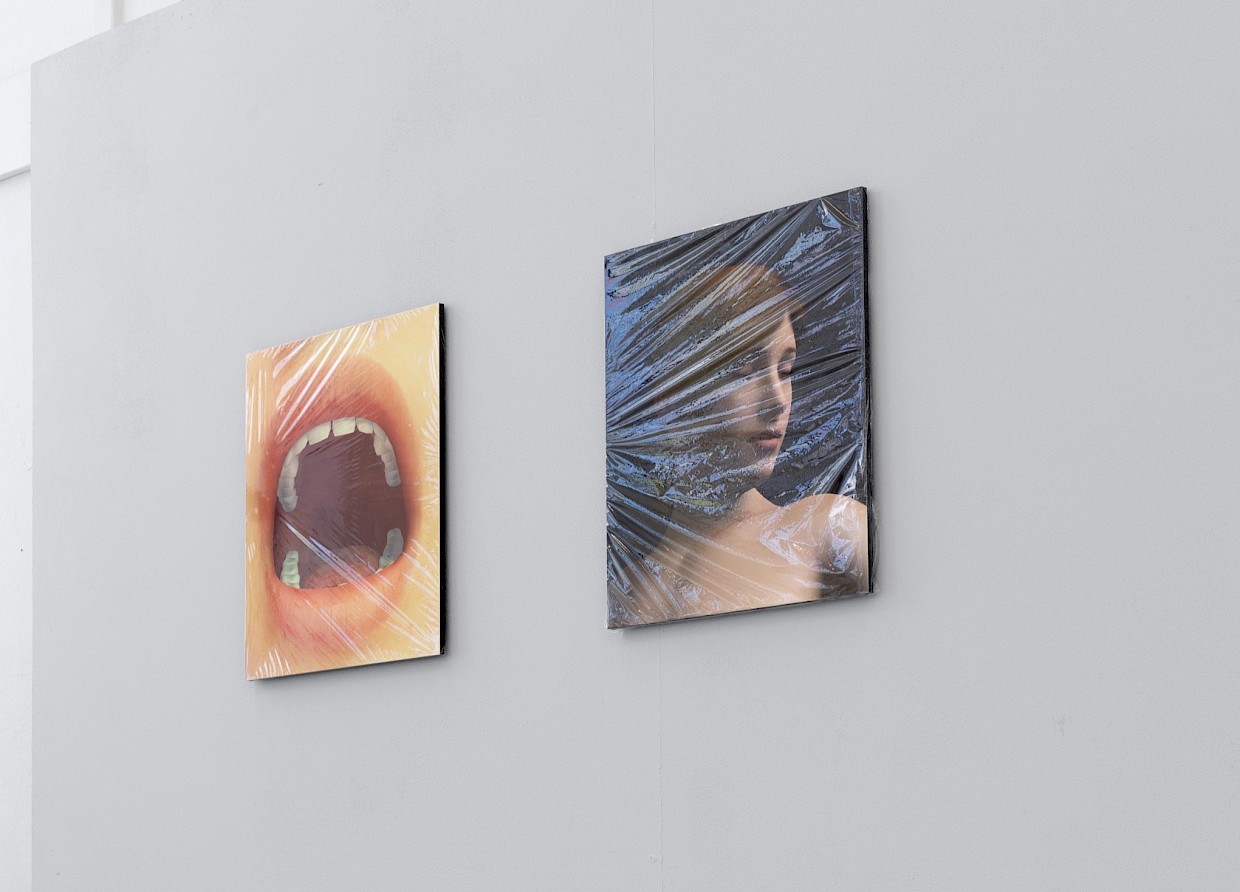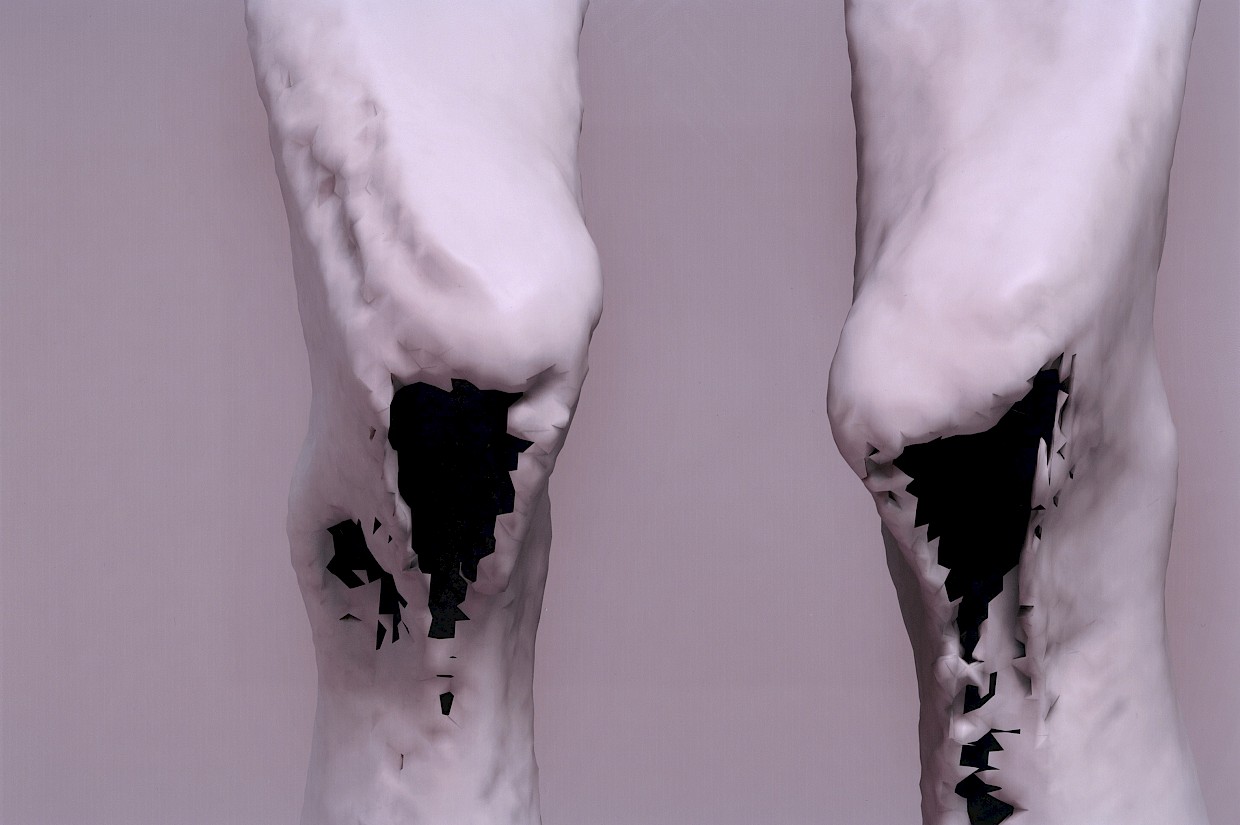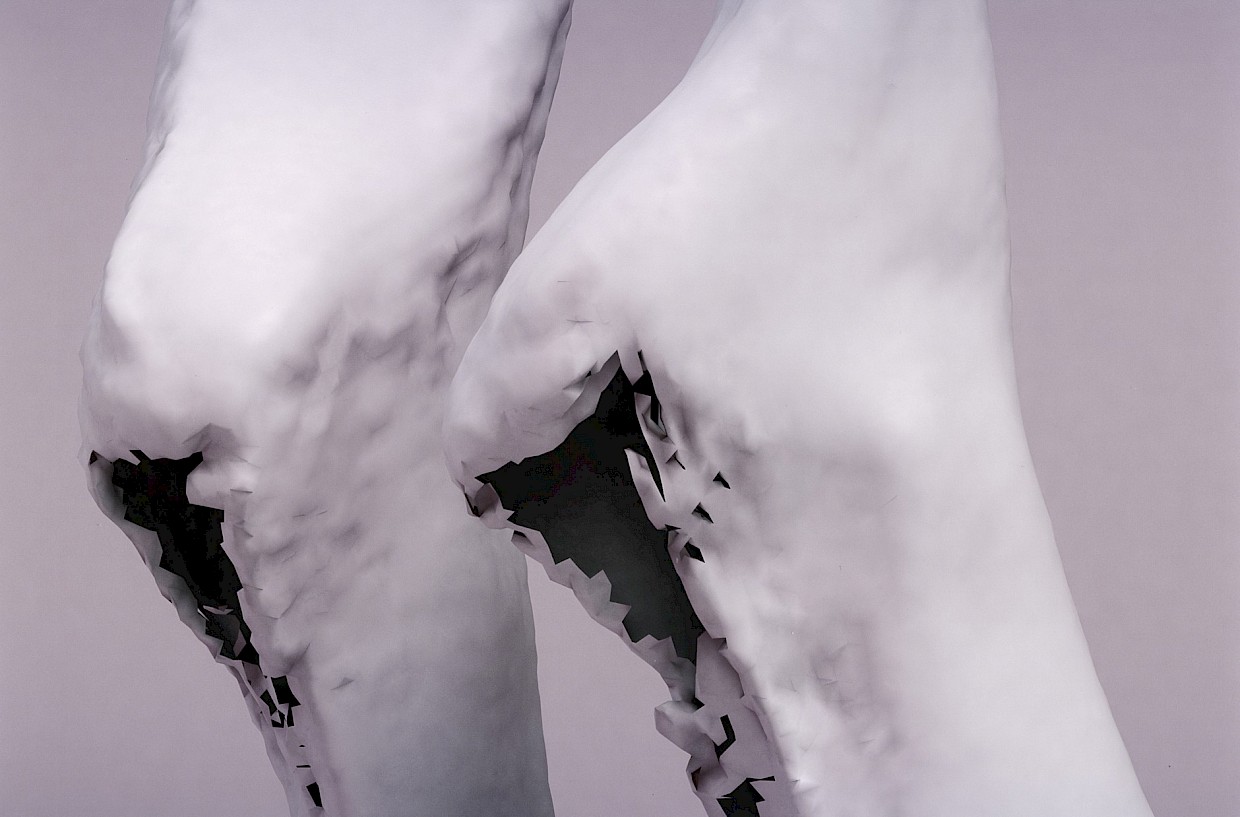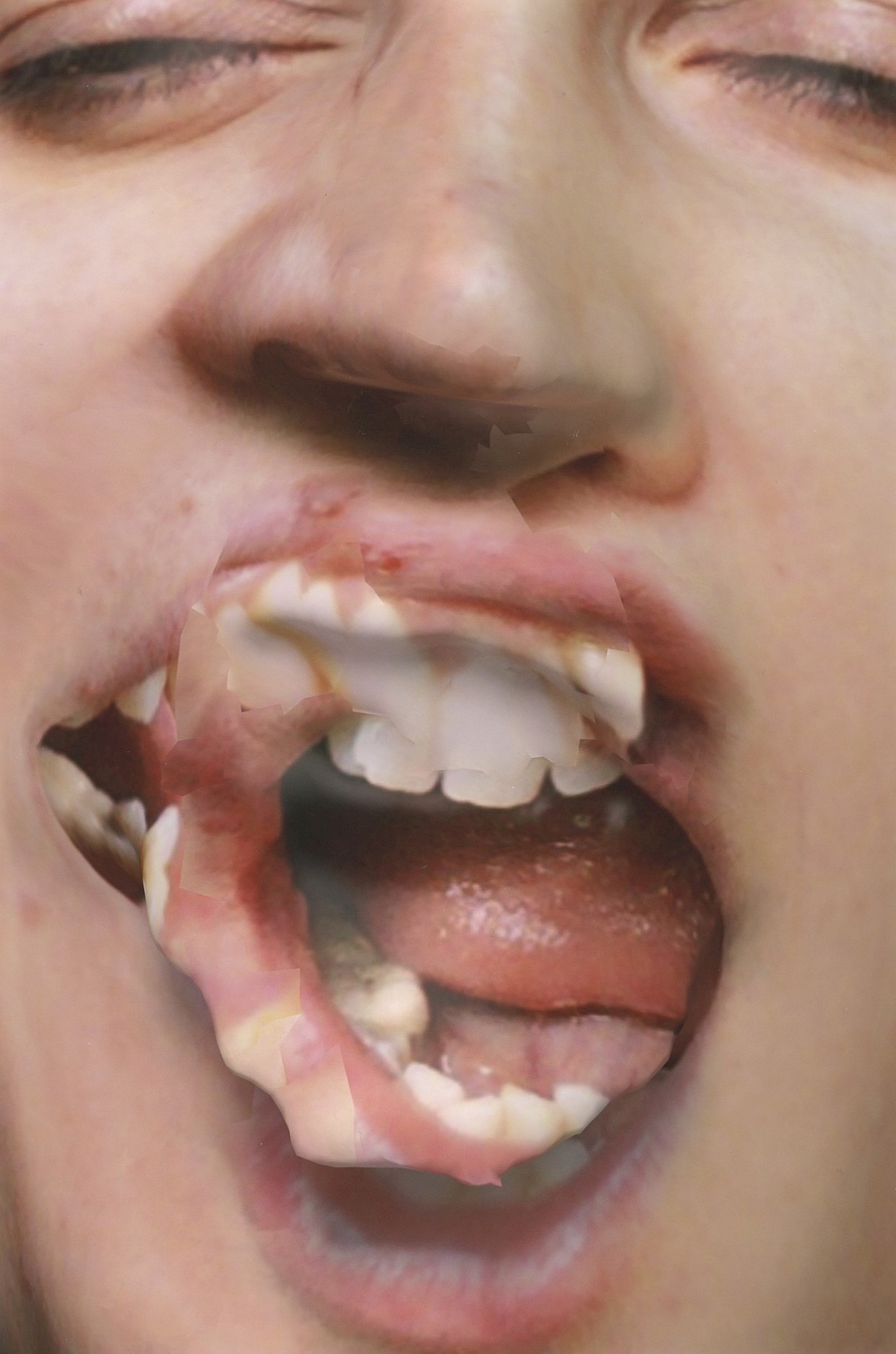Diana Gheorghiu
- Info
- CV
- Contact
There are those days, where the body says no; and the mind says no too. You dissolve, a heap of flesh rests on the floor. A Sartrian ennui is the only emotion you can feel – overwhelm, dissociate, breathe in, breathe out, repeat - and get back to work. Diana Gheorghiu (RO, 1985) reveals how distorted our physical and mental experience of life can become under high capitalism, where our bodies are worn out and pushed to self-care under the same capitalist conditions that create such disintegration.
Gheorghiu works in various media, from video and spatial installations to social media projects, encompass the realms in which a capitalo-fascist industry catches up with us to seduce and convert our minds. The uncanny actions of CGI’s, very human-like but not quite so, confront us with the hypocrisies and consequences of a self-care industry that smartly plays those traumatized by neglect from the regular healthcare system. Gheorghiu represents this systematic abuse through recurrent characters. You know them too: the gym guy, an entrepreneur, the yoga mom. They are the epitomes of the perfect capitalist body, the good fellows who abide by the rules and successfully operate within ‘the system’. We follow these characters in their apocalyptic post-human sitcom, where seemingly only white and prosperous bodies escape the rebel spaces on earth. Gheorghiu tackles the realities of living with the threat of commercialized space travel, symbols of the imminent apocalypse, extreme economic gaps in an unaffordable economy, chronic illness, mental health and the erasure of the poor. Overmedicated and undertreated bodies fight for their survival, as the earth grows tired, cold and inhabitable.
In sickness and in health, our bodies are serving the higher good of fueling an economy with our labor, consumption drive and energy. Are we still human?
Education
Royal Academy of Art, Photography Department, The Hague, KABK, NL
SAE Institute Media, 3D & Animation Course, NL
SAE Institute Media, VJ Visual Production Course, NL
National School of Political Studies and Public Administration, Communication and PR, SNSPA, RO
Exhibitions
Upcoming
12 Sept - 2 Feb 2025, GOGBOT x RMT, Rijksmuseum Twenthe, Enschede, NL
21 - 24 Nov, UNFAIR24, Gashouder, Westergas, Amsterdam, NL
Past
30 Aug - 30 Sep, Entangled, Kunstliefde,Utrecht, NL
28 Sep - 13 Oct, Whatever remains unchanged is already dead, Das Leben am Haverkamp, Den Haag, NL
08 - 14 Apr, Dreams Online Film Festival, homecinema.video, WWW
14 Apr - 09 Jun, 16UP, 38CC, Delft, NL
31 Jan - 04 Feb, The New Current, Rotterdam, Brutus, NL
01 Nov - 01 Mar 2024, The Wrong Biennale, WWW
01 Nov - 01 Dec, CAV - Multimedia Art Center, Spam Index, Bucharest, RO
26 - 30 Sep, Cinema Ikon, MAFA - Media Art Festival Arad, Arad, RO
24 Jun, The Shortest Dream of the Year by Home Cinema, Moos Space, Berlin, DE
24 Jun - 29 Jul, Things That Take Time, Torch Gallery, Amsterdam, NL
08 - 11 Jun, Springboard Art Fair, Utrecht, NL
09 - 12 Feb, Prospects 2023, Art Rotterdam, Rotterdam, NL
05 Nov - 18 Dec, Promising II, PARK, Tilburg, NL
04 - 18 May, arebyte on screen, Arebyte London, WWW
10- 11 Jun, Companions in misfortunes, LA Artcore, Los Angeles, USA
15 Jan - 27 Deb, Virtual Virality, Online Intimacy and Digital Detox, Melkweg Expo, Amsterdam, NL
11-21 Nov, If it fools you, it is not fake, Tetem, Enschede, NL
24 Sept, Morning Routine with Kexin Hao & Diana Gheorghiu, PIP Expo, The Hague, NL
08 Sept–09 Oct, The Current Affair of Some Young Romanian Artists , Ivan Gallery, Cazul 101, Bucharest, Ro
05–29 Sept, Untired, Pulchri Studio, The Hague, NL (Solo Show)
25 May–7 June, Miranda, Apprentice Master, Kunstpodium T, Tilburg, NL
05 Jan–29 Feb, Baitball 01, Like A Little Disaster / Harlesden High Street, Polignano a Mare (Bari), IT
02 Aug–01 Sept, Arty Party: Photography Exhibition #2, Melkweg Expo, Amsterdam, NL
5–11 Jul, Graduation Festival, Royal Academy of Art, The Hague, NL
21–23 Jun, SUB, Suprainfinit Gallery, Bucha rest, RO
23–28 May, Push It To The Limit, Melkweg Expo, Amsterdam, NL
14 Mar, PPS 4, AiciAcolo Gallery, Cluj-Napoca, RO
18 Dec–20 Jan, Security in Pictures, Humanity House, The Hague, NL
15 Dec, Night of the Conflict, Theater aan het Spui, The Hague, NL
25–30 Jan, Noun Presents Good Work, Grey Space in the Middle, The Hague, NL
24 Mar, Noun Presents, VSVU, Bratislava, SK
Publications
2020
Cover for Cutra magazine, Romanian intersectional feminist magazine 2019 – kunstenaar diana gheorghiu wil dat we stoppen met streven naar perfectie / I D Netherlands 2018 – ALT Magazine, de Alternatieve Veiligheidsraad
Commissions
De Correspondent “Hoe diverser de Tweede Kamer, hoe beter de besluiten – en hoe rechtvaardiger onze samenleving”, by Valentijn De Hingh, 2021
PlatformBK “Call Out Culture / Cancel Culture”, by Alina Lupu, 2021
De Correspondent “Sommige coronapatiënten zijn maanden later nog ziek. Waar zijn zij in het coronabeleid?“, by Sanne Blauw, 2020
The Correspondent “Why the world can get worse by constantly saying it’s getting better”, by Nesrine Malik, 2020 (published also in De Correspondent)
De Correspondent “Onze favoriete fictieboeken voor in je strandstoel“, by Rosan Smits, 2019 De Correspondent “Een documentaire over het beste festival dat nooit plaatsvond. En nog 7 kijktips voor de zomer.”, by Rosan Smits, 2019
De Correspondent “Naar deze podcasts luisteren onze correspondenten“, by Rosan Smits, 2019 Spam Index “WELL, WELL, WELL”, collaborative project with Alina Lupu, 2019
Humanity House, Still Life with Bird Crashing a Wall, The Hague, 2018
Grants
STROOM Den Haag PRO Invest, 2023
MONDRIAAN Stipendium for Emerging Artists 2023
MONDRIAAN Stipendium for Emerging Artists 2021
STROOM Den Haag PRO Research, 2021
Other
Bartalk #23, Hype, “Wellness industries trends” | speaker.
Apprentice Master 2019, Master: Nathalie Hartjes | together with Lola Safari and Yung Nora, a project initiated by Kunstpodium T, Tilburg
‘You Are Light and Cabbage,’ is a video sculpture that serves as an altar dedicated to a wellness influencer symbolized by a cabbage head. The project aims to illustrate how social media is being exploited to spread misinformation, COVID conspiracies, and far-right ideologies by engaging in discourse rooted in magical thinking.
In the video work, Cabbagehead’s message is addressed to its three followers: the yoga mum, the entrepreneur and the tennis player, each one referring to an existing character in real life.
The characters are shown travelling in a car filled with cabbages and crashing into a rock in the desert. They die and so they meet their deity, a cabbage head, who preaches them about reconnecting with nature, harnessing their inner strength, cultivating positive thinking, trusting their intuition, and letting themselves be guided by the law of attraction.
The project was made in collaboration with: Tristan Gieler, 3D Animation, Jill Verweijen & Linnea Gerrits, Sculpture and set design, Luca van Grinsven, Sound, Joris de Jong, Voice, Alina Lupu, Text, Clara Lezla, Title design
For this project I created a virtual Instagram influencer named Angela Soothe, who promotes her own vitamin pills “Super Confident” with the promise of increasing confidence. The artwork encompasses a series of images posted on the Instagram account @fast_ing_and_furious and a triptych printed on an acrylic plate. This project delves into the confidence culture that women have been exposed to in recent years. Despite the deepening gender, class, and racial inequalities, women are repeatedly encouraged to believe in their abilities.
“Super Confident” is a critique of the notion that confidence is solely reliant on an individual’s willpower, rather than being influenced by their environment and the societal norms to which they have been exposed.
The central piece of the project is the triptych, featuring two women in a familiar setting. One woman exudes confidence as she sits on the edge of a couch while wearing a mask. The other woman, younger in appearance, gazes in awe at her companion, reclining on the couch. The surroundings reflect the lifestyle associated with wellness, displaying objects that promote a “healthy lifestyle” prevalent in that world. Positioned on the shelf in the background of the photos is a bottle of the vitamin pills, featuring a QR code label that can be scanned in the physical world to redirect viewers to the Instagram page.
This project was commissioned by Tetem Enschede for the “If it fools you it is not fake” SprintExpo program where I paricipated together with Sonia Mangiapane and Valentina Gal.
“Ice bath”, 2021, is a site-specific installation part of the duo exhibition I had together with Kexin Hao at PipExpo during Hoogtij Den Haag for which I printed a large scale shower curtain.
The Swans was created with the occasion of an invitation from the Romanian CUTRA magazine, in 2020. In this project I thought of our relationship with nature, and how we actually take it down in order to build it back up again. One simple example of this is the way we cut down a forest to replant the trees and sell them, or we destroy the ocean and the sea life and we build swimming pools instead. Due to the impossibility, at the time, of setting up a live presentation for the works during the COVID-19 pandemic, my visual contributions ended up being displayed online on the CUTRA platform, as well as in a virtual exhibition of feminist art, 7 scenes at 360°, alongside the works of Admina, alex horghidan, Anna Grozavu, Maria Dimancea, Simina Popescu, in an environment created by Tăietzel Ticălos. The virtual exhibition can still be accessed at: cutra.ro
I made Untired in 2020. The project took the wellness industry and resistance to it as its starting point. At its core, wellness is the individualization of health concerns, the replacement of a ‘makeable society’ by the malleable self. Wellness sells health as a lifestyle choice, a lie that has been successfully countered by the ongoing COVID 19 pandemic.
Through this work, I resolved to offer a critique of the pressure of the individual that wellness establishes. The work was presented as an installation created for my solo exhibition at Pulchri Studio in The Hague in September 2020. I used as a visual space the realm of the bedroom, because the bedroom is the place where we retreat, in defiance of the pressures of treatments and clean living regimes. I focused not so much on “what” the wellness industry is offering, but rather on the question of “why” in relation to ourselves. To be more precise: why do we strive to be clean, and serene at this particular moment in time? What does the pursuit of these goals say about us? What is missing from our lives that leads us to seek spirituality in a retreat, or purification through dieting?
Ultimately, by rebuilding the bedroom as a space of defiance I hoped to allow the character I’ve built up to escape by saying that: you can’t sell anything to a sleeping woman. The text that follows, authored by the post-conceptual artist Alina Lupu, accompanied my work installed at Pulchri.
This video is part of the “Miranda” project, made in collaboration with Nathalie Hartjes (director of MAMA Rotterdam), and the artists Lola Safari and Yung Nora. The project took shape in the spring of 2020, under the framework of Kunstpodium T - an Apprentice Master program that helps young graduating artists hone their presentation skills.
The character I’ve created for the video is called Miranda. She’s a woman that is starting to have her doubts about the self-care and wellness industries and begins presenting these in a confessional type of format. In the video, she’s seen suffering from vaginal candidiasis, a fungal infection caused by a yeast called Candida albicans. Candida normally lives on the skin and inside the body, in places such as the mouth, throat, gut, and vagina, without causing any problems, but it can grow out of control and cause infections. Some symptoms include vaginal itching or soreness, pain during sexual intercourse, pain or discomfort when urinating, and abnormal vaginal discharge.
In the video, Miranda is trying to fix her illness by submerging herself in a herbal bath. But as she does this she starts to realise that the bath is only a superficial cure to her illness, the roots of which are connected to other events in her life.
While putting together my material for this video I got inspired by confessional media, the idea that we increasingly start confessing our feelings and parts of our private life online.
Another point of influence for me was the section of goop entitled goop Ph.D., which references itself as a hub for thoroughly researched health information. goop is a wellness and lifestyle brand and company founded by actress Gwyneth Paltrow and launched in 2008. It has at its core new age principles. Throughout the years, goop expanded from a newsletter to a website, print magazine, and pop-up shop. goop has increasingly come under fire for marketing products that are harmful, based on pseudoscience, and which lack efficacy.
One of the most notorious products is their “Jade Egg” - proposed to be used as a form of vaginal weight lifting. It is, according to their website: “used by women to increase sexual energy, health, and pleasure.” Gynecologists were severely critical of these claims and, in September 2018 the Goop company agreed to pay $145,000 to settle a lawsuit alleging that goop has posted claims about the eggs and about a herbal remedy, both without scientific basis.
“Miranda” bridges this gap between the highly personal, and the corporate guidance we end up seeking to tame our bodily failures.
I made “H is for Healthy” in 2019 and presented it during my graduation from the Photography Department at the Royal Academy of the Arts in The Hague. I felt it was a bit like a gateway drug. It’s the first project in which my initial thoughts about the wellness industry got crystallized. I started by questioning where the will to educate ends and where the selling pitch starts.
My approach in tackling the visual side of the project was rational. I made an inventory of all possible new-age-y therapies one could undergo and then I went about illustrating them, while also attempting to subvert them. It was my first brush with the iconic goop - the multi-million dollar wellness and lifestyle brand run by Gwyneth Paltrow.
I believe Gwyneth has a natural, effortless look and she is super popular because she’s coming up with treatments that make a buzz in the media. One such treatment: vagina steaming. Additionally, she sells a candle that smells like her vagina. No matter the effectiveness of these products, what’s clear is that Gwyneth can sell. She also made the news when a woman undergoing bee sting acupuncture died because of the venom that entered her body.
Gwyneth Paltrow is one of the wellness gurus that endorse apitherapy. Apitherapy is a branch of alternative medicine that uses honey bee products, including honey, pollen, bee venom, propolis, and royal jelly. Within apitherapy, bee venom can have a positive effect, but sometimes, like in this case, things can go down the wrong path.
These anecdotes and varied therapies ended up being the inspiration for my graduation project and they ended up inspiring an art installation, like an abstract world where these ideas about our bodies and health can be stored.
Other therapies I illustrated within this project: the coffee enema and the garra fish pedicure.
A coffee enema is a colon cleanse used in alternative medicine. It has a double purpose, one is for the cleansing of your intestines, which is believed to be important and the other is to provide a good dose of caffeine to your liver, which is believed to help the liver detox more efficiently.
Within the garra fish pedicure, the fish are set loose in the water and end up eating the dead skin off one’s feet. In order to do this, the fish are starved in advance. The practice has its dose of animal cruelty, but it’s also not particularly hygienic to share the same fish with other people.
The not yet regulated wellness industry is built on extreme, unsustainable diets and detox advice, bee sting acupuncture, or regular colonics. As the wellness myths are spreading, the trust in reliable science decreases. In this age of misinformation, fake news, and twisted science, we should ask ourselves: where does the will to educate end and where does the selling pitch start?
The starting point of the work was the concept of “toxic positivity”.
The video work was accompanied by a publication in which I delved into the topic of smiling in photography. I was curious when people started to smile in front of the camera since this wasn’t a universal state of presenting oneself.
This brought me to a few realizations. Among which is the fact that people didn’t always say “cheese” in photographs but they used to say “prune”, to expose a more solemn face. A grin was only characteristic of peasants, drunkenness, and children.
A few studies of the smiles in photography relate the “say cheese!” custom to the faces in media and politics and the rise of dental care which created the aesthetic of the teeth.
Other studies suggested that Kodak played a leadership role in shaping the conceptualization and the cultural habits around photography at the time when technology was becoming mass consume
In “Pain Is In The Eye Of The Beholder” I tackled visuals that balanced on the thin line between the traditional photographic image and computer renderings. I was intrigued by the notion of “surface” in photography and the inherent difficulty of photography in conveying the core of an event.
I delved into the feeling of pain as a starting point for the visuals and to support my work I got great inspiration from this quote from The Human Condition by Hannah Arendt:
“Indeed, the most intense feeling we know of, intense to the point of blotting out all other experiences, namely, the experience of great bodily pain, is at the same time the most private and least communicable of all. Not only is it perhaps the only experience which we are unable to transform into a shape fit for public appearance, it actually deprives us of our feeling for reality to such an extent that we can forget it more quickly and easily than anything else. There seems to be no bridge from the most radical subjectivity, in which I am no longer “recognizable,” to the outer world of life. Pain, in other words, truly a borderline experience between life as “being among men” (inter homines esse) and death, is so subjective and removed from the world of things and men that it cannot assume an appearance at all.”
Ultimately, I found that only through manipulating the image further, detaching it from the traditional photographic act, can one truly begin to trigger an affect that would somehow better convey the pain of the other.
